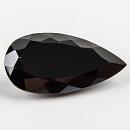|
|
||||||||||||||||
|
||||||||||||||||
|
||||||
|
|
|
|
Babingtonite
|
|
| | |
| Discovered in 1824; IMA status: Valid (pre-IMA; Grandfathered) | ||
|
| ||
|
Chemistry |
|
|
| |
|
Ca2(Fe2+;Mn)Fe3+Si5O14(OH) | |
|
|
Calcium Iron Manganese Silicate Hydroxide |
|
Molecular Weight: |
573.05 gm |
|
Composition: |
Calcium |
13.99 % |
Ca |
19.57 % |
CaO |
|
|
Manganese |
2.40 % |
Mn |
3.09 % |
MnO |
|
|
Iron |
17.05 % |
Fe |
21.94 % |
FeO |
|
|
Silicon |
24.51 % |
Si |
52.43 % |
SiO2 |
|
|
Hydrogen |
0.18 % |
H |
1.57 % |
H2O |
|
|
Oxygen |
41.88 % |
O |
|
|
|
|
|
100.00 % |
|
98.60 % |
= TOTAL OXIDE |
|
|
|
||||
|
Classification |
|
|
| |
|
Silicates (Germanates) | |
|
8/F.27-20 | |
|
|
9 : SILICATES (Germanates) D : Inosilicates
|
|
Related to: |
Babingtonite Group. Babingtonite-Manganbabingtonite Series. |
|
Members of Group: |
Babingtonite Group: Babingtonite, Manganbabingtonite, Scandiobabingtonite |
|
Varieties: |
None |
|
Synonyms: |
None |
|
|
|
|
Crystal Data |
|
|
|
|
|
Stubby, prismatic, striated crystals, to 3 cm; also platy and as subparallel aggregates. |
|
|
None |
|
|
|
|
|
Physical Properties |
|
|
|
|
|
Perfect on {001}, good on {010} and {100}. |
|
|
Irregular/Uneven to Subconchoidal |
|
|
Brittle |
|
|
5.5 - 6.0 |
|
|
3.34 - 3.37 (g/cm3) |
|
|
None |
|
|
Not Radioactive |
|
|
Other: |
Weakly Magnetic |
|
|
|
|
Optical Properties |
|
|
|
|
|
Almost always black; black to dark greenish black |
|
|
Opaque to faintly translucent in thin crystals or splinters |
|
|
Vitreous |
|
|
1.700 - 1.725 Biaxial ( - ) |
|
|
0.025 |
|
|
Strong; r > v |
|
|
X = deep green; Y = lilac-brown; Z = pale to deep brown. |
|
|
|
|
|
Occurances |
|
|
|
|
|
Geological Setting: |
Veins cutting granitic pegmatites and diorites, cavities and vugs in mafic volcanic rocks and gneisses, skarns. |
|
Common Associations: |
Prehnite, Calcite, Epidote, Albite, Orthoclase, Garnet, Quartz, "Hornblende," Zeolites. |
|
Common Impurities: |
Ti, Al, Mg, Na |
|
Type Locality: |
Arendal Iron Mines, Arendal, Aust-Agder, Norway |
|
Year Discovered: |
1824 |
|
View mineral photos: | |
|
|
|
|
More Information |
|
|
|
|
|
| |
|
|
|
|
Babingtonite was first described in 1824 from samples from the Arendal Iron Mines, Arendal, Aust-Agder, Norway (the type locality) and was named after Dr. William Babington (May 21, 1756 - April 29, 1833), physician and mineralogist, curator of the John Stuart, 3rd Earl of Bute mineral collection until 1792, founding member and President (from 1822 to 1824) of the Geological Society of London and author of noted systematic books on mineralogy (1796 - 1799). Babingtonite is the official mineral of the Commonwealth of Massachusetts. Known
from a number of localities, most minor; some of the
loalities providing
good crystals are: in Norway, at the Brastad mine, Oyestad,
near Arendal. From Gronsj÷berg, Dalarma, Sweden. In
Germany, at Herbornseelbach, Hesse. From Baveno, Piedmont,
Italy. In the Khandivali quarry, near Bombay, Maharashtra,
India. At Mitani, Kochi Prefecture, Japan. From Noril'sk,
western Siberia, Russia. In the USA, in Massachusetts,
exceptional crystals from Lane's quarry, Westfield,
Hampden County; in the Cheapside and Deerfield quarries,
East Deerfield, Franklin County; also at Winchester
Highlands, Uxbridge, Norfolk County. At Paterson, Passaic
County, and Mine Hill, Morris County, New Jersey; from
the Goose Creek quarry, Leesburg, Loudoun County, Virginia;
and at Lenoir, Caldwell County, North Carolina. |
|
|
We
have not photographed our Babingtonite
gems yet. Please
check back soon. |
